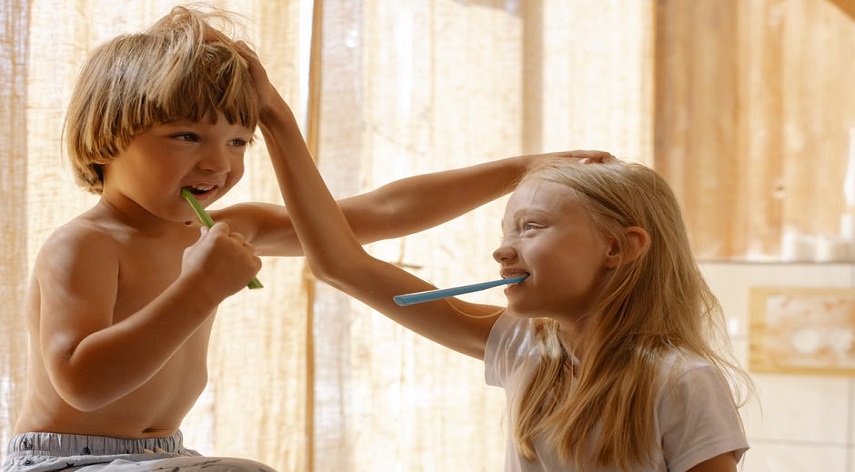Teaching Your Child the Importance of Dental Hygiene

A healthy smile boosts confidence. Healthy teeth and gums can help prevent heart disease. A healthy mouth can reduce the risk of cancer.
You can give your child good dental hygiene habits that will last a lifetime. Learn more about how to teach your kids how fun caring for teeth can be.
Table of Contents
ToggleSet a Good Example
Your actions are even more important than your words when it comes to dental hygiene. Young children want to imitate what their parents do. If they see you brushing and flossing, they’ll want to do it too.
Let your kids watch you caring for your teeth. Show them that it’s enjoyable and not a chore.
You can also explain what you’re doing. This helps teach good brushing techniques. For example, describe how you brush all the way to the back molars and spit out the toothpaste instead of swallowing.
Start when Your Child is a Baby
Even before your child’s teeth come in, you can start teaching good dental hygiene. Wipe your baby’s gums gently with a moist washcloth after they finish eating. This helps establish a healthy routine.
Once the first tooth comes in, you can start using a soft finger brush or an infant toothbrush. Brush the teeth gently twice a day.
Demonstrate Good Brushing and Flossing
Young children don’t have the dexterity or fine motor skills to brush their teeth well. When you first start teaching your child about good dental hygiene, you’ll probably need to do the brushing.
Stand behind them and hold the toothbrush comfortably. As you brush and floss, tell them what you’re doing. Let them hold the toothbrush with you to experience how it feels.
Supervise Independent Dental Hygiene
Children will reach the age when they want to do everything themselves. You can let your child find the toothpaste and toothbrush. Supervise as they put toothpaste on the toothbrush.
You can let your child brush independently. Watch carefully, though. You’ll need to go back and clean any areas your child missed.
Let Your Child Pick Their Toothbrush
Letting your child pick their own toothbrush helps them feel more invested in their dental hygiene. You can find many different types of cute character toothbrushes for kids.
Be sure that the toothbrush is the right size. A toothbrush that’s too big won’t clean very well. It will be harder for your child to use.
Also, look for a toothbrush with soft bristles. Firm bristles can irritate the mouth and make brushing unpleasant. Most toothbrushes for children have these features, but double-checking is still important.
Choose a Child-Friendly Toothpaste
Most adults like minty fresh breath. Mint can be too strong for kids, though. Fruity or bubble gum flavors can be more popular choices.
Many brands of toothpaste for children have colorful packaging featuring TV or movie characters. Your child can choose the one they like best.
When you’re helping your child choose toothpaste, look for one with fluoride. Fluoride strengthens the tooth enamel. It can even help permanent teeth as they develop.
Make Dental Hygiene Fun
You can have fun teaching the importance of healthy teeth and gums. Children and adults should brush their teeth for two minutes. You can use a song to be sure you’re brushing for the right amount of time.
You can even dance around the bathroom! Just be sure you’re still using good brushing techniques.
A timer can help you make brushing into a game. The winner is the one who brushes for the full two minutes.
Try Other Activities that Promote Caring for Teeth
Teaching your children about good dental hygiene goes beyond the time you brush and floss. Videos, books, and games can reinforce lessons about healthy teeth and gums.
You can find a variety of fun and educational videos online. Apps with oral health games are also engaging for kids. Try reading books about dental hygiene and going to the dentist.
When playing with stuffed animals or dolls, brush their teeth. Your child can be the “parent” and show their stuffed animal how to brush. These activities can help get your child excited about preventing cavities.
Keep Healthy Teeth and Gums with Braces
Braces become a part of life for many children and teens. This guide for children’s braces will give you an overview of the types of braces and how they work.
Good dental hygiene is even more important when your child has braces. Preventing cavities is more difficult if food gets trapped under the braces.
Brushing is a little more complicated with braces. You can help your child to get their teeth as clean as possible.
Your child should start by rinsing with water to loosen anything stuck around the braces. Then, brush at the gumline below the braces.
Next, brush on top of the brackets with the toothbrush angled down. Finally, brush at the bottom of the brackets with the toothbrush angled up. This will help to remove plaque and food debris.
Your child can clean between their teeth with a floss threader. Water irrigators are another good choice.
Reward Good Brushing and Flossing
When your child follows good dental hygiene, reward them. You can make a calendar and let your child choose a sticker for each day they brush and floss correctly.
For older children, you can track how well they’re caring for their teeth. You can set a goal after which they earn a larger reward.
Give Your Child the Gift of Beautiful Teeth
Good dental hygiene is essential for kids’ health and self-esteem. You can start teaching the right habits when your child is a baby. Your good brushing and flossing can provide a model for your kid.
As your child gets older, they can take more responsibility for their dental hygiene. Making brushing and flossing fun helps your kids develop healthy habits.
Beautiful teeth can last a lifetime. Start teaching your kids today!
Check out our other health articles for more ways to improve life for you and your family.
Pankaj Majumder, a seasoned Civil Engineer, combines technical expertise with a passion for innovative infrastructure solutions. With a strong academic background and diverse project experience, he excels in creating sustainable and resilient structures that shape the future of urban development.
Recommended For You
Spread the loveAre you striving to lose weight without sacrificing your health? With weight loss advice seemingly coming from every
Spread the loveSeniors with Parkinson’s disease (PD) can lead satisfying lives, even though there is currently no cure for the
Spread the loveHave you ever stumbled upon an IP address that seems to be shrouded in mystery? One such enigmatic





